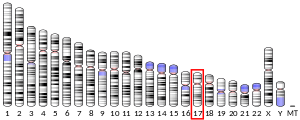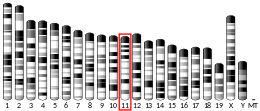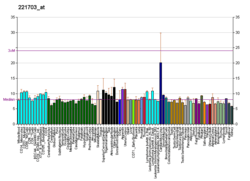BRIP1
Fanconi anemia group J protein is a protein that in humans is encoded by the BRCA1-interacting protein 1 (BRIP1) gene.[5][6][7]
Function
The protein encoded by this gene is a member of the RecQ DEAH helicase family and interacts with the BRCT repeats of breast cancer, type 1 (BRCA1). The bound complex is important in the normal double-strand break repair function of breast cancer, type 1 (BRCA1). This gene may be a target of germline cancer-inducing mutations.[7]
This protein also appears to be important in ovarian cancer where it seems to act as a tumor suppressor.[8] Mutations in BRIP1 are associated with a 10-15% risk of ovarian cancer.[9]
Interactions
BRIP1 has been shown to interact with BRCA1.[10][11][12][13][14][15]
gollark: Anyway, I did slightly introduce horrible bodges to make the one-introspection-module thing work, but it's *basically* usable.
gollark: They either require 14 or so, or arbitrarily large quantities.
gollark: Most applications do not require 8000 digits of Tau.
gollark: This is slightly convenient, yes?
gollark: I even added a Milo Remote-like interface which *doesn't need an introspection module in your neural interface*.
References
- GRCh38: Ensembl release 89: ENSG00000136492 - Ensembl, May 2017
- GRCm38: Ensembl release 89: ENSMUSG00000034329 - Ensembl, May 2017
- "Human PubMed Reference:". National Center for Biotechnology Information, U.S. National Library of Medicine.
- "Mouse PubMed Reference:". National Center for Biotechnology Information, U.S. National Library of Medicine.
- Menichini P, Linial M (November 2001). "SUVi and BACH1: a new subfamily of mammalian helicases?". Mutation Research. 487 (1–2): 67–71. doi:10.1016/s0921-8777(01)00104-5. PMID 11595410.
- Cantor SB, Bell DW, Ganesan S, Kass EM, Drapkin R, Grossman S, Wahrer DC, Sgroi DC, Lane WS, Haber DA, Livingston DM (April 2001). "BACH1, a novel helicase-like protein, interacts directly with BRCA1 and contributes to its DNA repair function". Cell. 105 (1): 149–60. doi:10.1016/S0092-8674(01)00304-X. PMID 11301010.
- "Entrez Gene: BRIP1 BRCA1 interacting protein C-terminal helicase 1".
- Rafnar T, Gudbjartsson DF, Sulem P, Jonasdottir A, Sigurdsson A, Jonasdottir A, et al. (October 2011). "Mutations in BRIP1 confer high risk of ovarian cancer". Nature Genetics. 43 (11): 1104–7. doi:10.1038/ng.955. hdl:2336/228034. PMID 21964575.
- Ring KL, Garcia C, Thomas MH, Modesitt SC (November 2017). "Current and future role of genetic screening in gynecologic malignancies". American Journal of Obstetrics and Gynecology. 217 (5): 512–521. doi:10.1016/j.ajog.2017.04.011. PMID 28411145.
- Botuyan MV, Nominé Y, Yu X, Juranic N, Macura S, Chen J, Mer G (July 2004). "Structural basis of BACH1 phosphopeptide recognition by BRCA1 tandem BRCT domains". Structure. 12 (7): 1137–46. doi:10.1016/j.str.2004.06.002. PMC 3652423. PMID 15242590.
- Joo WS, Jeffrey PD, Cantor SB, Finnin MS, Livingston DM, Pavletich NP (March 2002). "Structure of the 53BP1 BRCT region bound to p53 and its comparison to the Brca1 BRCT structure". Genes & Development. 16 (5): 583–93. doi:10.1101/gad.959202. PMC 155350. PMID 11877378.
- Yu X, Chini CC, He M, Mer G, Chen J (October 2003). "The BRCT domain is a phospho-protein binding domain". Science. 302 (5645): 639–42. Bibcode:2003Sci...302..639Y. doi:10.1126/science.1088753. PMID 14576433.
- Rodriguez M, Yu X, Chen J, Songyang Z (December 2003). "Phosphopeptide binding specificities of BRCA1 COOH-terminal (BRCT) domains". The Journal of Biological Chemistry. 278 (52): 52914–8. doi:10.1074/jbc.C300407200. PMID 14578343.
- Clapperton JA, Manke IA, Lowery DM, Ho T, Haire LF, Yaffe MB, Smerdon SJ (June 2004). "Structure and mechanism of BRCA1 BRCT domain recognition of phosphorylated BACH1 with implications for cancer". Nature Structural & Molecular Biology. 11 (6): 512–8. doi:10.1038/nsmb775. PMID 15133502.
- Wada O, Oishi H, Takada I, Yanagisawa J, Yano T, Kato S (August 2004). "BRCA1 function mediates a TRAP/DRIP complex through direct interaction with TRAP220". Oncogene. 23 (35): 6000–5. doi:10.1038/sj.onc.1207786. PMID 15208681.
Further reading
- Kobayashi A, Yamagiwa H, Hoshino H, Muto A, Sato K, Morita M, Hayashi N, Yamamoto M, Igarashi K (March 2000). "A combinatorial code for gene expression generated by transcription factor Bach2 and MAZR (MAZ-related factor) through the BTB/POZ domain". Molecular and Cellular Biology. 20 (5): 1733–46. doi:10.1128/MCB.20.5.1733-1746.2000. PMC 85356. PMID 10669750.
- Joo WS, Jeffrey PD, Cantor SB, Finnin MS, Livingston DM, Pavletich NP (March 2002). "Structure of the 53BP1 BRCT region bound to p53 and its comparison to the Brca1 BRCT structure". Genes & Development. 16 (5): 583–93. doi:10.1101/gad.959202. PMC 155350. PMID 11877378.
- Luo L, Lei H, Du Q, von Wachenfeldt A, Kockum I, Luthman H, Vorechovsky I, Lindblom A (April 2002). "No mutations in the BACH1 gene in BRCA1 and BRCA2 negative breast-cancer families linked to 17q22". International Journal of Cancer. 98 (4): 638–9. doi:10.1002/ijc.10214. PMID 11920628.
- Karppinen SM, Vuosku J, Heikkinen K, Allinen M, Winqvist R (February 2003). "No evidence of involvement of germline BACH1 mutations in Finnish breast and ovarian cancer families". European Journal of Cancer. 39 (3): 366–71. doi:10.1016/S0959-8049(02)00498-7. PMID 12565990.
- Rutter JL, Smith AM, Dávila MR, Sigurdson AJ, Giusti RM, Pineda MA, Doody MM, Tucker MA, Greene MH, Zhang J, Struewing JP (August 2003). "Mutational analysis of the BRCA1-interacting genes ZNF350/ZBRK1 and BRIP1/BACH1 among BRCA1 and BRCA2-negative probands from breast-ovarian cancer families and among early-onset breast cancer cases and reference individuals". Human Mutation. 22 (2): 121–8. doi:10.1002/humu.10238. PMID 12872252.
- Suzuki H, Tashiro S, Sun J, Doi H, Satomi S, Igarashi K (December 2003). "Cadmium induces nuclear export of Bach1, a transcriptional repressor of heme oxygenase-1 gene". The Journal of Biological Chemistry. 278 (49): 49246–53. doi:10.1074/jbc.M306764200. PMID 14504288.
- Yu X, Chini CC, He M, Mer G, Chen J (October 2003). "The BRCT domain is a phospho-protein binding domain". Science. 302 (5645): 639–42. Bibcode:2003Sci...302..639Y. doi:10.1126/science.1088753. PMID 14576433.
- Rodriguez M, Yu X, Chen J, Songyang Z (December 2003). "Phosphopeptide binding specificities of BRCA1 COOH-terminal (BRCT) domains". The Journal of Biological Chemistry. 278 (52): 52914–8. doi:10.1074/jbc.C300407200. PMID 14578343.
- Cantor S, Drapkin R, Zhang F, Lin Y, Han J, Pamidi S, Livingston DM (February 2004). "The BRCA1-associated protein BACH1 is a DNA helicase targeted by clinically relevant inactivating mutations". Proceedings of the National Academy of Sciences of the United States of America. 101 (8): 2357–62. Bibcode:2004PNAS..101.2357C. doi:10.1073/pnas.0308717101. PMC 356955. PMID 14983014.
- Shiozaki EN, Gu L, Yan N, Shi Y (May 2004). "Structure of the BRCT repeats of BRCA1 bound to a BACH1 phosphopeptide: implications for signaling". Molecular Cell. 14 (3): 405–12. doi:10.1016/S1097-2765(04)00238-2. PMID 15125843.
- Clapperton JA, Manke IA, Lowery DM, Ho T, Haire LF, Yaffe MB, Smerdon SJ (June 2004). "Structure and mechanism of BRCA1 BRCT domain recognition of phosphorylated BACH1 with implications for cancer". Nature Structural & Molecular Biology. 11 (6): 512–8. doi:10.1038/nsmb775. PMID 15133502.
- Wada O, Oishi H, Takada I, Yanagisawa J, Yano T, Kato S (August 2004). "BRCA1 function mediates a TRAP/DRIP complex through direct interaction with TRAP220". Oncogene. 23 (35): 6000–5. doi:10.1038/sj.onc.1207786. PMID 15208681.
- Botuyan MV, Nominé Y, Yu X, Juranic N, Macura S, Chen J, Mer G (July 2004). "Structural basis of BACH1 phosphopeptide recognition by BRCA1 tandem BRCT domains". Structure. 12 (7): 1137–46. doi:10.1016/j.str.2004.06.002. PMC 3652423. PMID 15242590.
- Gupta R, Sharma S, Sommers JA, Jin Z, Cantor SB, Brosh RM (July 2005). "Analysis of the DNA substrate specificity of the human BACH1 helicase associated with breast cancer". The Journal of Biological Chemistry. 280 (27): 25450–60. doi:10.1074/jbc.M501995200. PMID 15878853.
External links
- Human BACH1 genome location and BACH1 gene details page in the UCSC Genome Browser.
- Human BRIP1 genome location and BRIP1 gene details page in the UCSC Genome Browser.
This article is issued from Wikipedia. The text is licensed under Creative Commons - Attribution - Sharealike. Additional terms may apply for the media files.




